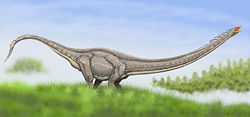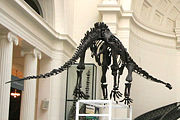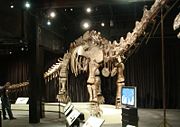Mamenchisaurus
2008/9 Schools Wikipedia Selection. Related subjects: Dinosaurs
| Mamenchisaurus Fossil range: Late Jurassic |
||||||||||||||||||
|---|---|---|---|---|---|---|---|---|---|---|---|---|---|---|---|---|---|---|
 |
||||||||||||||||||
| Scientific classification | ||||||||||||||||||
|
||||||||||||||||||
| Species | ||||||||||||||||||
|
Mamenchisaurus (pronounced /mɑːˈmʌntʃiːˈsɔrəs/ mah-MUN-chee-SAW-rus, or spelling pronunciation /məˌmɛntʃiːˈsɔrəs/) was a plant-eating four-legged dinosaur, known for its remarkably long neck. Most species lived 145 to 150 million years ago, in the Tithonian age of the late Jurassic Period.
Discoveries
Mamenchisaurus was first discovered in 1952 on a highway construction site in Sichuan, China. The partial skeleton fossil was then studied, and named in 1954, by the renowned Chinese paleontologist Professor C. C. Young.
The first specimen discovered (the type specimen) was 22 meters (72 feet) long and nearly half of that was neck, which made it the longest known neck of any animal at the time. 19 vertebrae were discovered (another record), along with long rods that were found in the neck.{{fact))
In 1972, a second species of Mamenchisaurus was discovered (M. hochuanensis) with a neck that reached up to 9.5 meters (31.5 feet) in length. In 1994, the Sauroposeidon was discovered in the United States, with a neck estimated to be between 10.5 and 11.5 meters (34.5 - 37.5 feet) long, though its neck did not exceed that of the previously known Supersaurus, with a neck reaching 13-14 meters (42.5 - 46 feet).
In 1993, M. sinocanadorum was described, this species possessed the longest cervical rib of any described sauropod dinosaur measuring 4100 mm. This is longer than the longest Sauroposeidon cervical rib which measures 3420mm.
Naming
Mamenchisaurus means 'Mamenchi lizard', from the Chinese Pinyin mǎ (马 'horse') and mén (门 'gate'), while chi is a transliteration of xī (溪 'stream' or 'brook'), combined with the suffix -saurus (from Greek sauros meaning 'lizard').
It was intended to name the reptile after the place where its fossil was first found — a construction site next to the Mǎmíngxī (马鸣溪) Ferry Crossing by the Jinsha River (金沙江, the westernmost major headwater stream of the Yangtze River), near Yibin (宜宾) in Sichuan Province of China. However, due to an accentual mix-up by Young, the location name Mǎmíngxī (马鸣溪 'horse-neighing brook') was mistaken as Mǎménxī (马门溪 'horse-gate brook').
The fact that the first Mamenchisaurus fossil was excavated from a construction site led to Young's naming the type species as Mamenchisaurus constructus.
Species
- M. anyuensis He, Yang, Cai, Li & Liu, 1996
- M. constructus Young, 1954: ( Type species) The holotype specimen, represented by a partial skeleton.
- ?M. fuxiensis Hou, Zhao & Chu, 1976: Partial skeleton, include parts of a skull. It was originally named Zigongosaurus, and may be a different genus.
- M. hochuanensis Young & Zhao, 1972: Four partial skeletons.
- M. sinocanadorum D. Russell & Zheng, 1994: Partial skull, isolated bones. It may have been the largest, up to 26 meters (85 feet) in length.
- M. youngi Pi, Ouyang & Ye, 1996: Mamenchisaurus youngi (pronunciation YOUNG-eye) was unearthed in Xinmin County, Zigong City in Sichuan Province, China, in 1989. The fossil specimen, 16 meters long with a 6.5-meter neck, is relatively small among various species of Mamenchisaurus. The species was named in honour of Young.
Popular Culture
- Mamenchisaurus was mentioned on the episode " Blood Ties" (Season 3, Episode 20) of Alias by Sydney Bristow and a Museum worker while she was undercover in a museum at a dinosaur exhibit.
- Mamenchisaurs were featured in the roundup scene in Jurassic Park's sequel, The Lost World: Jurassic Park.
- A Mamenchisaurus featured in a travelling Dinosaurs from China exhibition which toured Australia in 2002.


